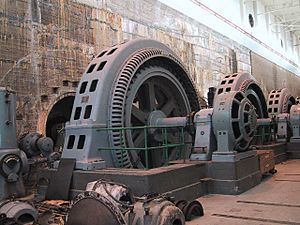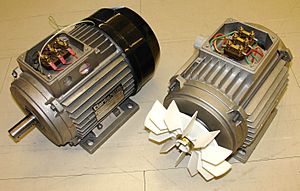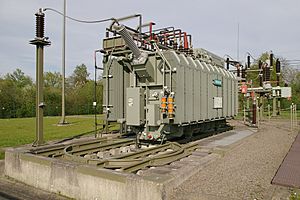Electrical machine facts for kids
An electrical machine is a special device that changes energy from one form to another. Most of the time, it turns mechanical energy (like movement) into electrical energy (like the power that runs your phone) or changes electrical energy back into mechanical energy. These machines are super important in our daily lives, powering everything from your bicycle light to huge factory equipment.
Contents
What Are Electrical Machines?
Electrical machines are the backbone of our modern world. They help us use electricity in many ways. Think about how electricity gets to your home or how your electric scooter moves. Electrical machines are involved in all these steps. They are designed to handle different amounts of power, from tiny amounts for small gadgets to massive amounts for entire cities.
How Do Electrical Machines Work?
These machines work by using the relationship between electricity and magnetism. This is called electromagnetism. When electricity flows through a wire, it creates a magnetic field around it. Also, if you move a wire through a magnetic field, it can create electricity. Electrical machines use these principles to either create movement from electricity or create electricity from movement.
Types of Electrical Machines
There are three main types of electrical machines that you should know about:
Electrical Generators
An electrical generator is a machine that takes mechanical energy and turns it into electrical energy. Imagine a wind turbine spinning in the wind. The wind makes the blades turn, which is mechanical energy. Inside the turbine, a generator uses this spinning motion to create electricity. This electricity can then be sent to homes and businesses.
- How they work: Generators usually have coils of wire that spin inside a strong magnetic field. As the wires cut through the magnetic field, electricity is produced.
- Where you see them: Power plants use huge generators to make electricity from burning coal, natural gas, or from hydroelectric power (water power) and wind power. Smaller generators can be found in cars to charge the battery or in portable generators used during power outages.
Electrical Motors
An electrical motor does the opposite of a generator. It takes electrical energy and changes it into mechanical energy, usually in the form of spinning motion. This spinning motion can then be used to power all sorts of things.
- How they work: Motors have coils of wire that become temporary magnets when electricity flows through them. These temporary magnets interact with permanent magnets (or other temporary magnets) inside the motor, causing a part of the motor to spin.
- Where you see them: Electric motors are everywhere! They are in your electric fan, washing machine, refrigerator, electric car, drone, and even your electric toothbrush. Any device that spins or moves using electricity likely has an electric motor inside.
Transformers
A transformer is a bit different from generators and motors because it doesn't change energy from mechanical to electrical or vice versa. Instead, a transformer changes the voltage level of an alternating current (AC). Voltage is like the "pressure" of electricity.
- How they work: Transformers have two or more coils of wire wrapped around an iron core. When alternating current flows through one coil, it creates a changing magnetic field. This changing magnetic field then creates electricity in the other coil, but at a different voltage.
- Why they are important: Electricity is sent over long distances at very high voltages to reduce energy loss. Before it comes to your home, the voltage needs to be lowered to a safe level. Transformers do this job. They also step up voltage for transmission or step down voltage for use in homes and factories.
- Where you see them: You can see large transformers at power substations near your town. Smaller transformers are inside many electronic devices, like the charging block for your phone or laptop, to change the wall outlet voltage to the voltage your device needs.
The Importance of Electrical Machines
Electrical machines are essential for our modern way of life. They allow us to generate, transmit, and use electricity efficiently. Without them, we wouldn't have electric lights, working computers, or many of the conveniences we rely on every day. They are key to how we power our homes, transport ourselves, and run industries around the world.
See also
 In Spanish: Máquina eléctrica para niños
In Spanish: Máquina eléctrica para niños




